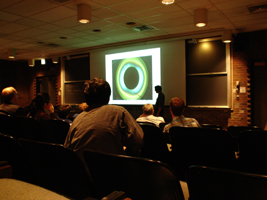Workshop: summary
Day 1: Meshing Science and Pedagogy
Paul Williams talked about gravity waves in a rotating two-layer annulus. Two immiscible liquids of slightly different densities and a superrotating lid drive a baroclinic flow.  Two chemicals, Limonene, and CFC-113 in the fluid, when illuminated from the botom, result in correlations between observed color and height of the interface. Results showed wavenumbers of 1 or 2 plus gravity waves an order of magnitude smaller in amplitude and scale. A large-scale transition between wavenumbers 1 and 2, similar to polar vortex transition, was observed and interpreted as a noise-induced transition. Safety issues were discussed again, including the use of chemicals. Safer, optically active chemicals have not yet been tested, although sugar solution was suggested as one possibility. It was suggested that the danger of the rotating turntable itself is overstated, with the exception of men’s ties (and hair), while the danger of lasers and chemicals is possibly underemphasized.
Two chemicals, Limonene, and CFC-113 in the fluid, when illuminated from the botom, result in correlations between observed color and height of the interface. Results showed wavenumbers of 1 or 2 plus gravity waves an order of magnitude smaller in amplitude and scale. A large-scale transition between wavenumbers 1 and 2, similar to polar vortex transition, was observed and interpreted as a noise-induced transition. Safety issues were discussed again, including the use of chemicals. Safer, optically active chemicals have not yet been tested, although sugar solution was suggested as one possibility. It was suggested that the danger of the rotating turntable itself is overstated, with the exception of men’s ties (and hair), while the danger of lasers and chemicals is possibly underemphasized.
"Teaching ideas could come from classic papers (e.g. JFM) but educators rarely have technical background to sort through such literature," maintained John Knox. For example, the classical Plumb and McEwan QBO experiment is beautiful, but not easy to set up or interpret. A simpler wave-mean flow example due to MyIntyre and Norton consists of kitchen counter items (oven dish and cheese slicer). John demonstrated this live and used an OHP to show it on the wall. Mean flow generated by the wave makers persisted for some time after the waves ceased. Difference from the Stokes drift was discussed. Students may be asked, for example, to describe what they observed and whether they would expect the same result from a convex (as opposed to concave) wave maker. (A "false eyewitness” effect was found in one occasion.) In the following discussion Kathie Mackin emphasized the importance of asking students to predict experimental outcomes beforehand and explain why their predictions did or did not materialize.
Ole Nost discussed the wind-driven circulation of the North Sea-Arctic Ocean system. It is primarily a closed-basin system, with the primary wind forcing over the North Sea. A rotating tank connected to a second sub-basin represents the ocean system and shows the characteristic strong boundary layer flow illustrative of the Arctic ocean boundary current. Cyclonic rotation of the sub-basin results in cyclonic rotation of the adjacent basin, with the flow following the sloping boundary. The rotation of sub-basin remained cyclonic even after the rotation of the turntable was reversed, contrary to the linear theory. In these anticyclonic cases the nonlinearities are important, relative vorticity is advected, and the flow travels away from the edge of the sloping boundary. An explanation was given in terms of potential vorticity conservation. The size of the experimental tank (5 meters long) led to discussion of the appropriate size for experiments in college settings. It was suggested that an appropriate size is small enough to maneuver necessary equipment around yet large enough to engage students in hands-on learning.